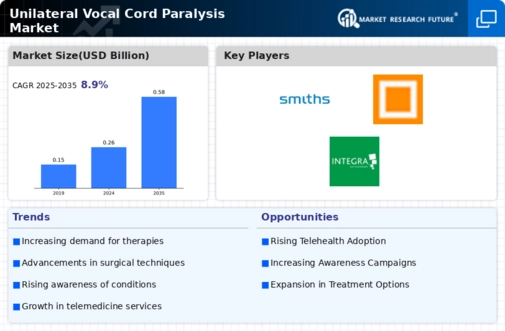Unilateral Vocal Cord Paralysis Size
Unilateral Vocal Cord Paralysis Market Growth Projections and Opportunities
Prevalence and Incidence : The market for unilateral vocal cord paralysis is influenced by the number of individuals diagnosed with this condition. Prevalence rates vary globally, with factors such as age, gender, and underlying medical conditions contributing to incidence rates.
Diagnostic Techniques : Advancements in diagnostic technologies play a significant role in the market dynamics. Improved imaging techniques, such as laryngoscopy and electromyography, enhance the accuracy of diagnosis, potentially increasing the demand for treatment options.
Economic Factors : Economic conditions and healthcare expenditure patterns impact the market for unilateral vocal cord paralysis treatments. Access to healthcare services, insurance coverage, and out-of-pocket expenses influence the adoption of therapies and surgical interventions.
Treatment Landscape : The availability and efficacy of treatment options influence market dynamics. Therapies range from voice therapy and vocal cord injections to surgical procedures like medialization laryngoplasty. Variations in treatment outcomes and patient preferences shape market demand.
Technological Innovations : Technological advancements in surgical techniques and medical devices drive market growth. Minimally invasive procedures, such as laser surgery and endoscopic approaches, offer improved outcomes and reduced recovery times, potentially expanding the market.
Regulatory Environment : Regulatory policies governing medical devices and pharmaceuticals impact market access and product development. Compliance with safety standards and approval processes influence market entry strategies and competitive positioning.
Research and Development : Ongoing research efforts contribute to the expansion of treatment options and therapeutic approaches. Investments in clinical trials, biomaterials, and regenerative medicine hold the potential to transform the market landscape.
Patient Demographics : Demographic trends, such as aging populations and lifestyle factors, shape market demand. Age-related changes in vocal cord function and the increasing prevalence of chronic conditions affecting the larynx drive the need for interventions among specific patient groups.
Physician Practices : Treatment patterns and referral practices among healthcare providers influence market dynamics. Collaboration between otolaryngologists, speech-language pathologists, and other specialists impacts the continuum of care and patient outcomes.
Patient Awareness and Education : Public awareness campaigns and patient education initiatives impact market dynamics. Increased awareness of symptoms, risk factors, and available treatment options may lead to earlier diagnosis and intervention, driving market growth.
Reimbursement Policies : Reimbursement policies set by government payers and private insurers affect market access and affordability. Coverage for diagnostic procedures, therapeutic interventions, and rehabilitative services influences patient choices and healthcare provider reimbursement.
Competitive Landscape : Competition among pharmaceutical companies, medical device manufacturers, and healthcare providers shapes market dynamics. Product differentiation, pricing strategies, and marketing efforts influence market share and profitability







Leave a Comment